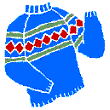|
|
- A- Ni' 'untsu kwthu yasa'qws?
|
Where is his/her hat? |
|
|
His/her hat is here. |
- A- Ni' 'untsu kwthu xul'tuns?
|
Where is his/her pencil? |
|
|
His/her pencil is here. |
- A- Ni' 'untsu kwthu swetus?
|
Where is his/her sweater? |
|
|
His/her sweater is here. |
|
The suffix -s , which follows the noun, expresses the meaning "his", "her", "its", or "theirs".
| Ni' 'untsu kwthu swetus? |
"Where is his/her sweater?" |
| 'E'ut tthu swetus. |
"His/her sweater is here." |
| Ni' 'untsu kwthu poukws? |
"Where is his/her book?" |
| 'E'ut tthu poukws. |
"His/her book is here." |
When the noun ends in -s, we still write, and pronounce, another -s to express "his", "her", "its", or "theirs".
| Shelumtsus tu'i. |
"This is a ring." |
| 'E'ut tthu shelumtsuss. |
"His/her ring is here." |


